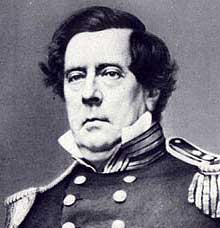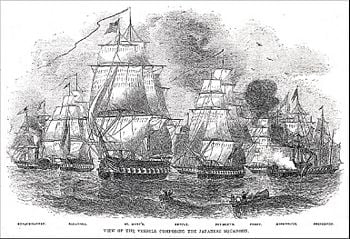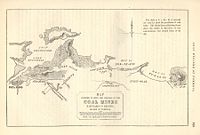Matthew C. Perry
Matthew Calbraith Perry (1794-1858) began his United States naval career when he was only fifteen years old under the command of his older brother. Matthew Perry’s first command was the schooner that sailed to Africa as part of the navy’s effort to stop the transatlantic slave trade. He also successfully commanded the largest American naval force during the Mexican War. Perry built a reputation for striving to keep his crew healthy as well as enforcing firm discipline. He promoted reforms for training naval officers and for expanding the use of steam power becoming known as the "father of the steam navy." Perry's most notorious achievement was his successful diplomatic mission to Japan resulting in that country opening its borders to a western nation for the first time in more than two hundred years. This opening up would have negative as well as positive consequences. However,it did lead to the rest of the world gaining much from exposure to Japanese culture and ingenuity as well as from commercial and trading links. Japan, arguably, has succeeded in retaining many aspects of its own culture, such as the importance of family, of education, of hard work and of disipline while also competing as an economic and technological power at the global level. Perry can also be credited with helping to transform the USA itself into a world player.
Born in Rocky Brook, Rhode Island, he was the son of Captain Christopher Raymond Perry and the younger brother of Oliver Hazard Perry. Matthew Perry obtained a midshipman's commission in the Navy in 1809, and was initially assigned to USS Revenge, under the command of his brother Oliver.
Perry's early career saw him assigned to several different ships, including the USS President, where he was aide to Commodore John Rodgers, which was victorious over a British vessel, HMS Little Belt, shortly before the War of 1812 was officially declared. During that war, Perry was transferred to USS United States, and consequently saw little fighting in that war afterward as the ship was trapped by the British blockade at New London, Connecticut. After the war he served on various vessels in the Mediterranean Sea and Africa notably aboard USS Cyane during its patrol off Liberia in 1819-1820. The Cyane was sent to suppress piracy and the slave trade in the West Indies. Later during this period, while in port in Russia, Perry was offered a commission in the Russian navy, which he declined.
Command assignments, 1820s-1840s
Opening of Key West
Perry commanded the USS Shark from 1821-1825.
When England possessed Florida in 1763, the Spanish contended that the Florida Keys were part of Cuba and North Havana. The United States felt the island could potentially be the "Gibralter of the West" because Key West guarded the northern edge of the 90 mile wide Straits of Florida — the deep water route between the Atlantic Ocean and the Gulf of Mexico.
In 1815, the Spanish governor in Havana, Cuba deeded the island of Key West, Florida to Juan Pablo Salas of Saint Augustine, Florida. After Florida was transferred to the United States, Salas sold the island to U.S. businessman John W. Simonton for $2,000 in 1821. Simonton lobbied the U.S. Government to establish a naval base on the island, both to take advantage of the island's strategic location and to bring law and order to the town.
On March 25, 1822, Perry sailed the schooner Shark to Key West and planted the United States flag, physically claiming the Keys as American property.
Perry renamed Cayo Hueso as Thompson's Island for the Secretary of the Navy Smith Thompson and the harbor as Port Rodgers for the president of the Board of Navy Commissioners. Neither name remained for very long.
From 1826-1827 he acted as fleet captain for Commodore Rodgers. Perry returned for shore duty to Charleston, South Carolina in 1828, and in 1830 took command of USS Concord. He spent the years of 1833-1837 as second officer of the New York Navy Yard which was later renamed the Brooklyn Navy Yard. Perry was promoted to captain when his assignment there ended.
Perry had a considerable interest in naval education, supporting an apprentice system to train new seamen, and helped establish the curriculum for the United States Naval Academy. He was also a vocal proponent of modernization of the Navy. Once promoted to captain, he oversaw construction of the Navy's second steam frigate, USS Fulton, which he commanded after it was commissioned. He organized America's first corps of naval engineers, and conducted the first U.S. naval gunnery school while commanding USS Fulton in 1839-1840 off Sandy Hook on the coast of New Jersey.
Promotion to commodore
Perry acquired the courtesy title of commodore in 1841, and was made chief of the New York Navy Yard in the same year. In 1843, he took command of the African Squadron, whose duty was to interdict the slave trade under the Webster-Ashburton Treaty, and continued in this mission through 1844.
The Mexican-American War
In 1845 Commodore David Connor was the commander of the United States Home Squadron. He was due for retirement. However, the coming of the Mexican American War persuaded the American Navy authorities to not change commanders in the face of the war. Perry, who would eventually succeed Connor, was made second-in-command and captained the USS Mississippi. Mexico had no offical navy making the United States Navy's role completely onesided. Perry captured the Mexican port city of Frontera, demonstrated naval might against Tabasco, and took part in the Tampico Expedition (1846). He was forced to return to Norfolk, Virginia to make repairs and was still there when the amphibious landings at Vera Cruz took place. His return to the U.S. did give his superiors the chance to finally give him orders to succeed Commodore Connor in command of the Home Squadron. Perry returned to the fleet during the siege of Veracruz and his ship supported the siege from the sea. After the fall of Veracruz, Winfield Scott moved inland and Perry moved against the remaining Mexican port cities. Perry assembled the Mosquito Fleet and captured Tuxpan in April, 1847. In July, 1847 he attacked Tabasco personally leading a 1,173 man landing force ashore and attacked the city from land.
The Opening of Japan: 1852-1854
Precedents
Perry's expedition to Japan was preceded by several naval expeditions by American ships:
- From 1797 to 1809, several American ships traded in Nagasaki under the Dutch flag, upon the request of the Dutch who were not able to send their own ships because of their conflict against Britain during the Napoleonic Wars.
- In 1837, an American businessman in Canton, China, named Charles W. King saw an opportunity to open trade by trying to return to Japan three Japanese sailors (among them, Otokichi) who had been shipwrecked a few years before on the coast of Oregon. He went to Uraga Channel with Morrison, an unarmed American merchant ship. The ship was attacked several times, and finally sailed back without completing its mission.
- In 1846, Commander James Biddle, sent by the United States Government to open trade, anchored in Tokyo Bay with two ships, including one warship armed with 72 cannons, but his requests for a trade agreement remained unsuccessful.
- In 1848, Captain James Glynn sailed to Nagasaki, leading at last to the first successful negotiation by an American with "Closed Country" Japan. James Glynn recommended to the United States Congress that negotiations to open Japan should be backed up by a demonstration of force, thus paving the way to Perry's expedition.
Background
Japanese ports had been closed the prior two centuries except for a few Dutch and Chinese traders. The United States wanted to begin trading with Japan because they needed Japanese ports to restock coal and supplies for the commercial whaling fleet and had an interest in the Japanese market.
Never before had the Japanese seen ships steaming with smoke. When they saw Commodore Perry’s fleet, they thought the ships were "giant dragons puffing smoke." They did not know that steamboats existed and were shocked by the number and size of the guns on board the ships.
First visit, 1852-1853
In 1852, Perry embarked from Norfolk, Virginia for Japan, in command of a squadron in search of a Japanese trade treaty. Aboard a black-hulled steam frigate, he ported USS Mississippi (1941), USS Plymouth (1844), USS Saratoga (1842), and USS Susquehanna (1847) at Uraga Harbor near Edo (modern Tokyo) on July 8, 1853, and was met by representatives of the Tokugawa Shogunate who told him to proceed to Nagasaki, where there was limited trade with the Netherlands and which was the only Japanese port open to foreigners at that time. Perry refused to leave and demanded permission to present a letter from President Millard Fillmore, threatening force if he was denied. Japan had for centuries rejected modern technology, and the Japanese military forces could not resist Perry's modern weaponry; the "Black Ships" would then become, in Japan, a threatening symbol of Western technology and colonialism.
The Japanese government accepted Perry's coming ashore to avoid a naval bombardment. Perry proceeded ashore at Kurihama, (near modern-day Yokosuka) on July 14, 1853, and presented the letter to delegates present and left for the Chinese coast, promising to return for a reply.
Second visit, 1854
Perry returned in February, 1854 with twice as many ships, finding that the delegates had prepared a treaty embodying virtually all the demands in Fillmore's letter. Perry signed the Convention of Kanagawa on March 31, 1854 and departed, mistakenly believing the agreement had been made with imperial representatives.
On his way to Japan, Perry anchored off of Keelung in Formosa, known today as Taiwan, for ten days. Perry and crew members landed on Formosa and investigated the potential of mining the coal deposits in that area. He emphasized in his reports that Formosa provided a convenient, mid-way trade location. The island was also very defensible. It could serve as a base for exploration in a similar way that Cuba had done for the Spanish in the Americas. Occupying Formosa could help the US counter European monopolization of the major trade routes. The United States government failed to respond to Perry's proposal to claim sovereignty over Formosa.
Barriers Broken Down
Perry assigned senior Naval officers for diplomatic duty. At the same time, he gathered an impressive naval squadron along with Marine ground forces. Fortunately Perry never had to actually carry out violence but strategically used this force as a threat on several occasions.
Another clever step by Perry was not allowing himself to be diverted by dealing with low ranking government officials. He brought a letter from the President of the United States, Millard Fillmore, to the Emperor of Japan. He patiently waited with his armed ships and insisted on dealing only with the highest emissaries of the Emperor.
Perry’s characteristic of working methodically, patiently, and persistently created an environment where he didn’t expect instant success but instead, incrementally applied effort over a time span of a full year. Even though Perry’s strategies may have appeared arrogant and perhaps aggressive, this framework built his success and produced the victorious results of his mission.
The Japanese government realized they were not in a position to defend itself and could not hold on to its isolation policy without a threat of war. Finally, on March 31, 1854, Perry and the Japanese government agreed on a treaty. [1]
The treaty proposed:
- Peace and friendship between the United States and Japan
- Opening of two ports to American ships at Shimoda and Hakodate
- Help for any American ships wrecked on the Japanese coast and protection for shipwrecked persons
- Permission for American ships to buy supplies, coal, water, and other necessary provisions in Japanese ports.
The Japanese invited the Americans to a feast after signing this treaty. The Americans were impressed by the courtesy and politeness of the Japanese hosts and amazed by the rich Japanese culture.
Commodore Perry was finally able to break down the barriers that separated Japan from the rest of the world. The Japanese still celebrate his expedition with annual black ship festivals. Perry lived in Newport, Rhode Island, which also celebrates a Black Ship festival in July. Newport has become Shimoda's sister city as a tribute to Commodore Perry.
Return to the United States, 1855
Upon Perry's return to the United States in 1855, Congress voted to grant him a reward of $20,000 in appreciation of his work in Japan. Perry used part of this money to prepare and publish a report on the expedition in three volumes, titled Narrative of the Expedition of an American Squadron to the China Seas and Japan.
Last years
Perry died three years later on March 4, 1858 in New York City. His remains were moved to the Island Cemetery in Newport, Rhode Island on March 21, 1866, along with those of his daughter, Anna, who died in 1839.
Trivia
- Perry's middle name is often misspelled as Galbraith.
- Among other mementos, Perry presented Queen Victoria with a breeding pair of Japanese Chin dogs, previously owned only by Japanese nobility.
- A replica of Perry's US flag is on display on board the USS Missouri (BB-63) Memorial in Pearl Harbor, Hawaii. It is attached to the bulkhead just inboard of the Japanese surrender signing site on the port side of the ship.
- His wife Jane Slidell was the sister of John Slidell. The city of Slidell, Louisiana is named after him. Jane Slidell also had another brother, Alexander Slidell Mackenzie, a naval officer, who commanded the USS Somers off the coast of Africa during the Blockade of Africa. [[2]]
Fictional depictions
The story of the opening of Japan was the basis of Stephen Sondheim & John Weidman's "Pacific Overtures".
Actor Richard Boone played Perry in a highly fictionalized film called "The Bushido Blade". Released in 1980, but produced earlier, it was marketed in such a way as to take advantage of the popularity of the Japanese-themed TV miniseries Shogun. It was not well received critically and did poorly at the box office.
The coming of Perry's ships is briefly mentioned in an episode of the anime (Japanese animated video) series "Rurouni Kenshin", and in the first episode of "Hikaru no Go". Another anime series in which Perry briefly appears is "Bokusatsu Tenshi Dokuro-chan". The manga,(Japanese comic strips) "Fruits Basket," also refers to the event while the main character is studying.
In the 23rd episode of the anime "Samurai Champloo", (Heart and Soul Into the Ball - Baseball Blues) a fictitious depiction of the black ships comes to the shores of Japan, several years earlier than Perry, to force trade with the Americans. However, they are distracted by the fact that they have a baseball and henceforth challenge them to a baseball game involving the main characters (much to their dismay), wagering the westernization of Japan. Though Perry doesn't physically appear, he's mentioned at the end of the episode. The Americans in the episode were given the march song, "The Stars and Stripes Forever," as their main theme.
External links
- http://www.history.navy.mil/branches/teach/pearl/kanagawa/friends4.htm A short timeline of Perry's life
- http://www.fordham.edu/halsall/mod/1854Perry-japan1.html Modern History Sourcebook
- http://mickmc.tripod.com/perry.html Commodore Matthew Calbraith Perry
- http://www.history.navy.mil/branches/teach/ends/opening.htm Naval Historical Center
- http://www.baxleystamps.com/litho/ry_litho_main.shtml General Information, The Perry Expedition
- http://www.archives.gov/exhibits/featured_documents/treaty_of_kanagawa The Treaty of Kanagawa
- http://www.usna.edu/LibExhibits/SpecialCollections/Perry.html Images from Perry's report on the expedition
Credits
New World Encyclopedia writers and editors rewrote and completed the Wikipedia article in accordance with New World Encyclopedia standards. This article abides by terms of the Creative Commons CC-by-sa 3.0 License (CC-by-sa), which may be used and disseminated with proper attribution. Credit is due under the terms of this license that can reference both the New World Encyclopedia contributors and the selfless volunteer contributors of the Wikimedia Foundation. To cite this article click here for a list of acceptable citing formats.The history of earlier contributions by wikipedians is accessible to researchers here:
The history of this article since it was imported to New World Encyclopedia:
Note: Some restrictions may apply to use of individual images which are separately licensed.


